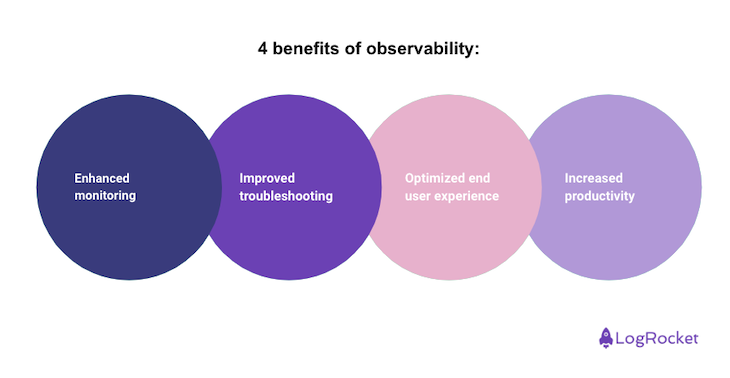As a product manager, you’re responsible for understanding how well your product performs at a given moment. Sometimes you can look towards KPIs, but often performance tracking can lead to an information overload. Shifting through multiple systems and metrics requires time and energy that could be spent somewhere else.

If any of this sounds familiar, you should consider observability. Observability helps remove some of the headaches associated with gauging performance by guiding you towards actionable insights.
In this article, you will learn what observability is, its associated benefits, and the best practices for implementing it within your product team.
Observability provides insights into the performance of your product based on the logs, traces, and metrics generated by your systems. Observability originated from the modern control theory that led to the implementation of self regulating machines. Gradually this was applied to the IT systems to monitor performance, which gave rise to the term observability.
Enterprises adopted cloud-native applications and services across the last few years. The increased complexity of integrated systems makes it difficult to track problems that may occur. With complex and distributed systems, teams need to analyze and troubleshoot applications to diagnose the root cause of errors.
Without observability in place, the conventional monitoring systems can only trace the known unknowns. Observability, on the other hand, provides the ability to understand patterns that haven’t occurred yet. Although the concept of observability is relatively new, organizations are rushing to adopt its immense benefits.
Observability helps you understand and gain insights into internal states and behaviors of your systems. There are four major benefits:

Observability allows you to detect potential issues before they impact a system. You can set up an intelligent alerting system based on performance data. This can help in preventing any potential issues while maintaining ideal system performance.
From observability, your developers gain knowledge on the system’s behavior that allows them to understand who owns each particular component. Increased visibility into the system helps identify root causes quickly. By looking at the logs, metrics, and traces, it’s easier to pinpoint the problematic areas and avoid any unnecessary time spent on diagnosing the issue.
You can use observability to identify issues before they even occur. This prevents any impact on the end users. You can also identify any potential improvements to continuously shift the product towards the needs of your users.
Observability leads to easier root cause analyses and diagnoses of issues. Without observability, developers need to spend time finding out who’s responsible for a particular service or application before they can fix a bug. Instead, the engineering team will have this information readily available.
By adopting observability, organizations can launch products faster, improve products quicker, and also increase their revenue by providing a stable software environment.
Observability is helpful for your role as a PM in four key ways:
Observability allows for valuable insights regarding feature adoption, usage, and customer feedback. Logs, metrics, and traces from observability help you analyze the adoption rate, the impact of new features, and user behavior. You can evaluate the success of your product features by tracking key performance indicators (KPIs).
By analyzing the real time data provided from observability, you can validate your hypothesis and receive insights into users’ interaction with your product. You will see an overview of the bottlenecks in the application and the pain point of users. The identified pain points or existing issues can then be prioritized on the roadmap based on the data from observability.
You can monitor the data post release to identify any production issues that might occur. By analyzing the logs, error rates, and impacted users, you can prioritize issues. User behavior and logs data availability makes it easier for you to collaborate with development and operations teams to resolve issues quickly.
Resource utilization like memory and network usage is critical for capacity planning. With this knowledge, you can scale your product to meet growing user demands. Analyzing observability data helps in identifying resource constraints and making data-driven decisions for infrastructure and capacity.
Observability empowers product managers to monitor product success, optimize user experience by introducing enhancements, prioritize production issues, and plan for scalability.
To take advantage of observability, follow these best practices:
Observability comes with its own set of challenges for implementation. Let us take a look at the key challenges:
The following types of organizations use observability to improve their end user experience by enhancing the product capabilities:
Observability is critical in IoT to monitor and manage connected devices. Analyzing the data in IoT devices enables you to manage your devices while providing insights to efficiently troubleshoot and keep the business running. For example, smart home systems use observability to monitor energy consumption, detect any anomalies, and receive alerts when needed.
Cloud platforms such as AWS, Microsoft Azure, and Google cloud platform monitor and analyze the performance of infrastructure components. These cloud platform tools provide observability features to identify and resolve performance issues or resource constraints.
Observability helps in monitoring and analyzing trading systems, as well as transaction processing and risk management. Through real time monitoring of market data and transaction flows, observability can help detect anomalies or fraudulent activities to ensure regulatory compliance.
Observability plays an important role in monitoring and understanding the behavior of distributed systems. Observability tools collect the data across distributed systems to analyze metrics, logs, and traces to provide meaningful insights into systems behavior. By identifying bottlenecks, troubleshooting issues, and sending alerts before a potential issue happens, observability can considerably reduce downtime and increase revenue for the businesses.
There are many different tools that you can implement within your team to capture the benefits of observability. The following are some of the best:
Dynatrace is a SaaS enterprise tool that offers an AI engine called Davis for root cause analysis and anomaly detection. It provides Infrastructure monitoring, log management, and application performance monitoring (APM). Its application monitoring allows it to monitor the performance and security of cloud applications.
Datadog is an observability tool for cloud-scale applications. It helps in monitoring infrastructure, applications, databases, network performance, as well as a full DevOps stack. Datadog provides an extended toolkit of security tools along with metrics monitoring.
Prometheus is an open source monitoring system that allows the storage, querying and capture metrics. It has a wide range of client libraries, integrations with efficient time series databases and modern alerting approach.
AppDynamics provides monitoring with visibility into all layers of application in real time. AppDynamics can monitor infrastructure, applications, databases and business performance. Additionally, it can also detect security vulnerabilities.
LogRocket monitors and understands user experience by capturing client side logs, performance data, and other information directly from the browser. By doing so, you can identify issues and enhance user experience and application performance.
LogRocket also collects client side logs and code level details along with high-fidelity session replay. The Galileo machine learning module automatically identifies, aggregates, and analyzes issues providing alerts for severe issues.
Observability solutions can help make your systems and applications observable, troubleshoot issues, detect critical issues before occurring, and generate business value. By keeping a tab on the insights provided by the observability tools, product managers can assign priority to issues that arise. The data can also help you make data driven decisions for determining further enhancements for your product.
Featured image source: IconScout

LogRocket identifies friction points in the user experience so you can make informed decisions about product and design changes that must happen to hit your goals.
With LogRocket, you can understand the scope of the issues affecting your product and prioritize the changes that need to be made. LogRocket simplifies workflows by allowing Engineering, Product, UX, and Design teams to work from the same data as you, eliminating any confusion about what needs to be done.
Get your teams on the same page — try LogRocket today.

A practical framework for PMs to use AI in ideation without sacrificing judgment, strategy, or decision quality.

A practical five minute revenue estimation method to help product managers compare ideas, drop low impact features, and prioritize smarter.

A practical guide for PMs who want to stop being bottlenecks, delegate smarter, and lead teams effectively with a clear ownership framework.

Stop letting unreliable data block features. Treat data as inventory to track quality, ownership, and ship with confidence.